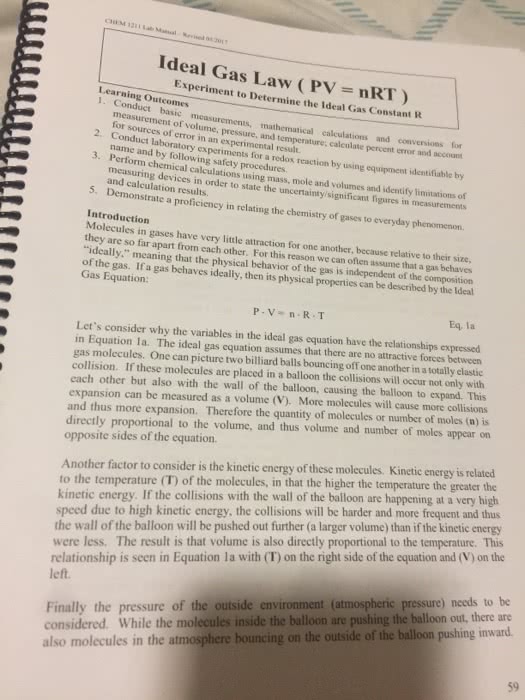CHEM 24112 Lecture Notes - Lecture 35: Ideal Gas, Torr, Kinetic Theory Of Gases

CHEMISTRY 112 – DAY 35 Chapter 13: Sections 7-8
4/16/18
KINETIC MOLECULAR THEORY and GAS LAW PRACTICE
Scientific Method
A law is a generalization of observed behavior.
Laws are useful – We can predict behavior of similar systems.
A model can never be proved absolutely true.
A model is an approximation and is destined to be modified.
So far we have considered “what happens,” but not “why.”
In science, “what” always comes before “why.”
Postulates of the Kinetic Molecular Theory
1. Gases consist of tiny particles (atoms or molecules).
2. The particles are so small, compared with the distances between them that the volume (size) of the
individual particles can be assumed to be negligible (zero).
3. The particles are in constant random motion, colliding with the walls of the container. These collisions
with the walls cause the pressure exerted by the gas.
4. The particles are assumed not to attract or to repel each other.
5. The average kinetic energy of the gas particles is directly proportional to the Kelvin temperature of the
gas.
Meaning of temperature
Kelvin temperature is directly proportional to the average kinetic energy of the gas particles.
Relationship between Pressure and Temperature
Gas pressure increases as the temperature increases because the particles speed up.
Relationship between Volume and Temperature
Volume of a gas increases with temperature because the particles speed up.
Use the Gas Laws to solve the following problems:
PV = nRT
(where R = 0.08206 L·atm/mol·K, the universal gas constant)
find more resources at oneclass.com
find more resources at oneclass.com
Document Summary
A law is a generalization of observed behavior. Laws are useful we can predict behavior of similar systems. A model can never be proved absolutely true. A model is an approximation and is destined to be modified. So far we have considered what happens, but not why. Gases consist of tiny particles (atoms or molecules). The particles are so small, compared with the distances between them that the volume (size) of the. 2. individual particles can be assumed to be negligible (zero). The particles are in constant random motion, colliding with the walls of the container. 3. with the walls cause the pressure exerted by the gas. The particles are assumed not to attract or to repel each other. The average kinetic energy of the gas particles is directly proportional to the kelvin temperature of the. Kelvin temperature is directly proportional to the average kinetic energy of the gas particles.


